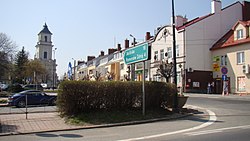Rymanów
| Rymanów | ||
|---|---|---|

market square
|
||
|
||
| Coordinates: 49°34′N 21°53′E / 49.567°N 21.883°E | ||
| Country |
|
|
| Voivodeship |
|
|
| County | Krosno | |
| Gmina | Rymanów | |
| Established | 14th century | |
| Town rights | 1376 | |
| Government | ||
| • Mayor | Jan Rajchel | |
| Area | ||
| • Total | 12.39 km2 (4.78 sq mi) | |
| Population (2006) | ||
| • Total | 3,564 | |
| • Density | 290/km2 (750/sq mi) | |
| Time zone | CET (UTC+1) | |
| • Summer (DST) | CEST (UTC+2) | |
| Postal code | 38-480 | |
| Area code(s) | +48 13 | |
| Car plates | RKR | |
| Website | http://www.rymanow.pl/ | |
Rymanów [rɨˈmanuf] (Latin: Rimanovia or Rimanoa) is a town of 3,585 inhabitants (02.06.2009) in Poland's Subcarpathian Voivodeship. It is a capital of a separate commune within the powiat of Krosno. It is located in the heartland of the Doły (Pits), and its average altitude is 420 metres (1,377.95 ft) above sea level, although there are some hills located within the confines of the city.
The town was built by the Duke of Silesia Władysław Opolczyk, the local representative of king Louis I of Hungary. Initially the town was named Ladisslavia, after the founder, and was inhabited primarily by settlers of central Germany (Reimannshau), largely overpopulated in late Middle Ages. In 1376 the town received a city charter based on the Magdeburg Law, which granted the town with a significant level self-government. During the reign of Ladislaus I of Poland the town received the modern name of Rymanów, after the first wójt Nicolao Reymann. The town was located on the traditional trade routes leading through the Carpathians to Hungary and in the 15th and 16th centuries it received numerous privileges from various Polish monarchs. This created a boost for local economy, mostly centred on the weekly fairs organized there. The period of prosperity ended in the 17th century, when this part of Poland was repeatedly pillaged and plundered by the invading armies during the wars against Muscovy, Sweden, Turkey and the Khmelnytsky Uprising. Throughout the ages, the town's history was interwoven with the fate of several notable Polish szlachta families. In 17th and 18th century the town was a private property of the Stadnicki family. In 1731 Teresa Stadnicka married Józef Kanty Ossoliński and the town passed to the mighty Ossoliński family, notable for their collections of books and pieces of art. The latter started the construction of an exceptional parochial church, finished by his daughter Anna Teresa. The latter in 1794 sold the town to family, who owned it until the 20th century.
...
Wikipedia


